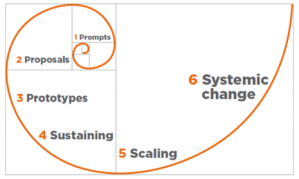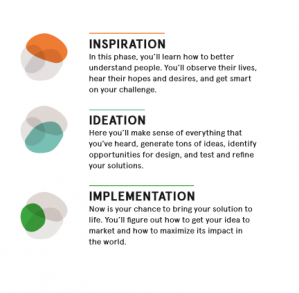SEDA/SEDA301/Identifying and Developing Socially Innovative Solutions/Developing innovative solutions
"Design thinking is a human-centered approach to innovation that draws from the designer's toolkit to integrate the needs of the people, the possibilities of technology, and the requirements for business success" Tim Brown, CEO of IDEO
"Human-centered design (or design thinking) offers problem solvers of any stripe a chance to design with communities, to deeply understand the people they’re looking to serve, to dream up scores of ideas, and to create innovative new solutions rooted in people’s actual needs" IDEO, 2015
The quote from Einstein provided above is highly relevant today. In order to design better services, experiences and solutions to current social problems, we need to develop new ways of thinking. Designing solutions that are effective require that the thinking process is human-centred. This is where design thinking, a new way of thinking, is an effective approach which can be, and is being utilised by social entrepreneurs.
Businesses, social enterprises and non-profits are all starting to embrace design thinking as the way to develop better solutions to problems faced by their customers and/or beneficiaries. A number of different frameworks have been developed to illustrate the stages involved in the design thinking process.
The framework above illustrates the cycle involved in design thinking, which commences with observation of needs and framing of opportunities and then moves on the ideation phase where creative thinking processes are used to experiment with ideas and develop possible solutions. After a period of testing and refinement, the idea is then implemented. Presentation as a spiral represents the iterative nature of this process, and the need to revisit certain stages as ideas change shape and grow.
Another fabulous source of information about the design thinking process is IDEO, an award-winning global design firm that takes a human-centered, design-based approach to helping organizations in the public and private sectors innovate and grow. Their process for human-centred design incorporates three stages:
As you can see from the above image, much overlap exists between IDEOs three-stage process and the spiral process provided above. The first key takeaway from both of these diagrams is the importance of observing and empathising with the individuals and communities you seek to support. The second key takeaway is the need to provide space to explore ideas for solutions to social needs (ideation). A number of different tools and methods are available to social entrepreneurs, some of which are detailed in greater depth in the resources to review box below, including Lecture 8. In this lecture, guest presenter Rachel Taylor presents for us a number of different strategies that social entrepreneurs may use to support the generation and consolidation of socially innovative ideas. A PhD Candidate at the Australian Innovation Research Centre (AIRC) within the Tasmanian School of Business and Economics (TSBE), Rachel's PhD study is examining the antecedents and consequences of social innovation within non-profit organisations and social enterprises in the Australian disability sector.
Lecture 8 - Slides: Developing Innovative Ideas
Online resource: IDEO.org, 2015. The Field Guide to Human-Centered Design. 1st Edition. Canada. (you will need to create a free account in order to download this resource for free). See link: http://www.designkit.org/resources/1
To further complement the provided design-thinking tools and processes, you may wish to explore a number of additional creativity tools which are available on the Mind Tools website.



